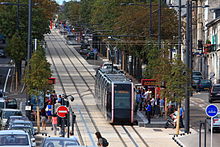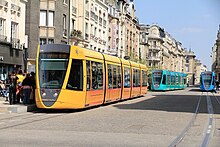Alimentation par le sol

Under Alimentation par le sol (abbreviation APS) refers to one from a subsidiary of the company Alstom for their Citadis tramways developed system for power supply. The power is not supplied via an overhead line , but rather via a power rail embedded in the route . This system was first used in the construction of the new tram in Bordeaux from December 2003 and was only started up there after initial difficulties.
functionality
In this system, there is a power rail between the two rails on which the wheels run, which can carry 750 volts DC voltage . The power rail is divided into individual sections. Each section consists of an eight-meter-long live rail and a three-meter-long insulated section.
The live part of the power rail is normally switched off so that passers-by are not endangered. If the busbar is run over by a tram, it sends a coded signal by radio to the control box ("coffret") embedded in the floor, which activates the section of the busbar that is entirely under the vehicle. A maximum of two of the eleven meter long segments can be activated at the same time. Every 22 m there is a control box embedded in the floor to control the power supply of the respective section. Before the tram leaves a segment, the section is switched off by the control box and grounded for safety reasons . The vehicles have two pantographs ("frotteurs") so that one of the two is always live, even if the other is driving over an isolated stretch.
There is also an automatic control station in the area of each station that monitors the operating status. If a section is live even though there is no tram above it, the entire section will be switched off within 0.2 seconds. The defective section is then identified, deactivated, and the remaining sections activated again. This process takes two seconds. If a section is defective and can no longer be activated until the damage has been rectified, the vehicles automatically switch to battery operation. You can then cover a maximum distance of 150 meters at a speed of 3 km / h.
The situation in Bordeaux
In order not to disturb the cityscape, the Bordeaux tram runs in the city center and in some suburbs without overhead lines. A total of 10,850 meters are equipped with the APS system.
In the outer areas of Bordeaux, the tram runs conventionally with overhead lines and pantographs . Switching to the other operating mode takes place during the stay at certain stops and is initiated by the driver. The process takes 20 seconds and does not extend the normal residence time. The manufacturer Alstom would have been able to design the system in such a way that switching between overhead contact line and APS takes place automatically and at full speed. For reasons of cost, this was not done and the task was given to the driver. If the driver forgets to switch, he is warned by a signal tone as soon as he tries to drive off.
The APS system is considered to be extremely innovative, but struggled with initial difficulties. Operational disruptions were the order of the day in the initial phase and replacement buses often had to be carried out, which resulted in additional costs of 500,000 euros per year. In the meantime, the system has achieved a satisfactory operational reliability, although occasional malfunctions still occur. The main cause is stagnant water after heavy rainfall, which can lead to electrical defects. Therefore, it was initially heavily criticized by the people of Bordeaux and the local press for its technical problems. The APS underground system is around three times more expensive to set up than a conventional overhead contact line and causes significantly higher maintenance and operating costs. The system also increases the price of each tram set by around 100,000 euros. However, those responsible for the project in Bordeaux point out that the tram cost only a quarter of what a subway would have cost.
Use in other cities
In the meantime, however, the advantages of the system have become apparent, and several cities are introducing it or are planning to introduce it. In the spring of 2011, a 2 km long section of the tram system in the APS system was put into service in Reims . The city of Angers built two 1.5 km long sections of their tram, which opened in June 2011, without overhead lines. In the Orléans tramway was APS system introduced in June 2012 on a section of the track B. Also Tours , with a 2013 opened 2 km long route GSP and Dubai decided to APS. The introduction of the APS system was also considered in other cities, including Marseille , Aachen , Nice (opted for battery), Edinburgh and Melbourne . The tram in Rio de Janeiro , completed in 2016, has been fully equipped with APS busbars.
Sydney has ordered 60 Citadis X05s with APS, which run on a 2 km long section in the city center without overhead lines.
Ten years after equipping the first railway line with the APS system, Alstom has equipped 151 trams with this technology. The APS lines have a total length of 43 km.
See also
The concept of the recessed center busbar was also brought to product maturity by other manufacturers, including Bombardiers Primove (inductive current flow) and Ansaldos Tramwave (magnetic contact closure). However, these have never been sold and there are only short test routes in Augsburg and Naples. For the removal of the overhead line in the cityscape, other manufacturers are relying primarily on the concept of accumulator railcars; among the systems offered, CAF's Acumulador de Carga Rápida is already being used on the Seville tram .
literature
- Christoph Groneck, Robert Schwandl: Tram Atlas France . 1st edition. Robert Schwandl Verlag, Berlin 2014, ISBN 978-3-936573-42-8 .
Individual evidence
- ↑ railwaygazette.com: Angers tram opens , June 29, 2011 Access 2 September 2011
- ↑ Press release of the French Consulate General in Rio de janeiro from Mail 2013 (French) accessed on April 22, 2014
- ↑ Sydney is the first Citadis X05 tram customer . railwaygazette. February 25, 2015.
- ↑ Press release (Dec. 2013) from Alstom on the 10th anniversary of APS, accessed on May 28, 2014





